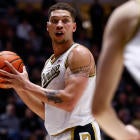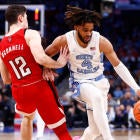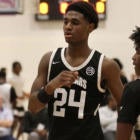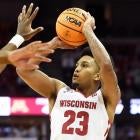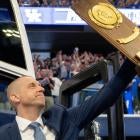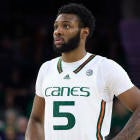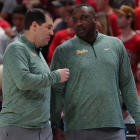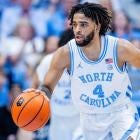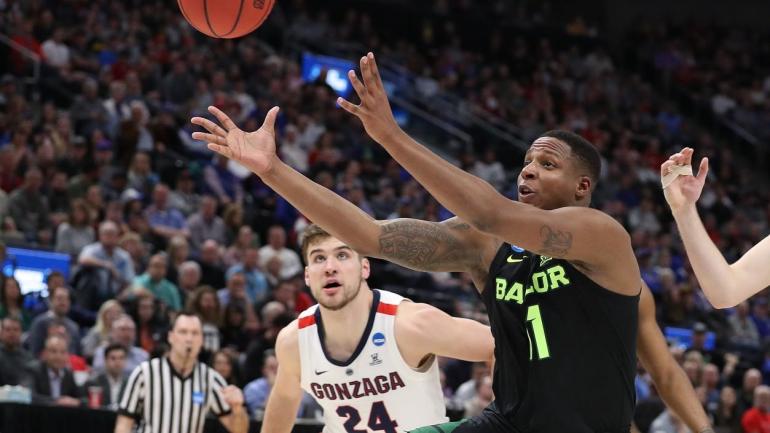
Gonzaga and Baylor are separated by 1,542 miles, two time zones and one spot atop every ranking imaginable. The two-team chase that's outpacing the rest of college basketball has grown into the sport's biggest story as of today, which marks exactly six weeks until the scheduled start of the NCAA Tournament.
This major plot point became even more pronounced after two top-five teams lost in shocking fashion on Wednesday, which also amounted to the biggest upset-laden night of the season. No. 3 Villanova was a 9.5-point favorite and fell by 11 at St. Johns; No. 5 Houston was a 16.5-point favorite against East Carolina and lost by nine. (No. 4 Michigan is off-radar on account of being in the midst of a three-week COVID pause. The Wolverines will continue to be spared.)
So it's Gonzaga and Baylor, then a canyon, then everyone else.
Ironically this storyline wouldn't exist to near the extent it does now if things had gone as planned. (But as we all recognize, so much has not gone to plan in the past 11 months of this pandemic.) The teams were scheduled to play each other in Indianapolis in early December. The game was axed less than two hours before tip because of COVID-19 positives with Gonzaga.
Had we gotten that game, college basketball would currently have two undefeateds instead of three (hey, Drake!) and the dominant talking point would be about whether the GU-BU winner could run the table. Instead, we're looking at a fun chance both could. That in mind, consider this: maybe losing that game was the better outcome. At this point it's a genuine, earnest and interesting debate over which is the better team, and that is driving discussion amid a season that is abnormally awful for blue bloods and Hall of Fame coaches that are headed toward once-in-a-generation NCAA Tournament exclusions.
Hopefully we'll get Gonzaga-Baylor -- in the national championship. But that's two months away, so let's continue to pace ourselves. The real reason I wanted to draw your attention to these two teams today is to put into perspective just how rare their double-dominant seasons are becoming.
While the Bulldogs and Bears are Nos. 1 and 2 in whatever order in all of the polls and rankings, there's a story to tell in KenPom's metric that brings to light just how special of a season these two are having. Statistics can bring traditional narratives into focus, and I'd like to do that here. For the uninitiated, KenPom's rankings are sorted by a metric known as adjusted efficiency margin, or AdjEM for short. As Pomeroy wrote in 2016, "AdjEM is the difference between a team's offensive and defensive efficiency. It's simple subtraction. Even your dog can do it." The formula calculates how many points (plus or minus) a team would be vs. the average team over 100 possessions within the context of that season.
Through 17 games apiece, Gonzaga and Baylor are playing at a historic level. As of Thursday morning Baylor's AdjEM is +35.41; Gonzaga's is not so far behind at +34.67 (and could creep closer with a win beyond 20 points Thursday night at Pacific). In third place is Michigan. The Wolverines, idle since Jan. 22 and not scheduled to return for more than a week still, are more than six points below in AdjEM at +28.09.
That's a phenomenal +6.58-point gap between Gonzaga and Michigan.
While it's true that BU and GU are flirting with all-time great AdjEMs on their own (only a few teams have ever finished a season +35.00 or better; it will be a challenge to sustain this come NCAA Tournament play), it's their separation from the rest of the sport that's notable. If this continues, we'll have only had one season like it in the past 24 years. Tourney performance can bring some understandable context (and noise) to end-of-season data, so I wanted to more fairly gauge everything pre-tournament. Pomeroy was kind enough to pull every season since the start of his database (1996-97) and see how many times there have been two teams +3.00 ahead of all others in AdjEM after Selection Sunday but before the start of the NCAA Tournament.
In other words: How many seasons have we seen a pair of teams be so much better than the rest of the sport the way Gonzaga and Baylor appear to be right now?
The answer: It's only happened once. And on only four previous occasions have there been two teams +3.00 or better. Here are the five biggest gaps between the second team and third team at KenPom at the start of the NCAA Tournament. If we inserted Baylor and Gonzaga right now, it would be No. 2.
| Season | KP #1 | AdjEM | KP #2 | AdjEM | KP #3, AdjEM | Diff. |
| '97-98 | UNC | +36.41 | Duke | +36.14 | Kentucky, +27.63 | 8.47 |
| '09-10 | Kansas | +32.51 | Duke | +31.55 | Syracuse, +27.58 | 3.96 |
| '04-05 | Illinois | +33.31 | UNC | +32.00 | Duke, +28.76 | 3.31 |
| '01-02 | Duke | +34.02 | Cincinnati | +30.85 | Kansas, +28.03 | 3.07 |
| '96-97 | Kentucky | +34.88 | Kansas | +32.41 | UNC, +29.32 | 2.89 |
The distance now between Gonzaga and Michigan is almost double (+6.58) the 2009-10 instance of Duke and Cuse. Ironically, that obscene abyss in 1998 led to neither Duke nor UNC winning the national title; Duke lost in the Elite Eight and UNC went down in the Final Four. (If you're wondering how the gulf could have been so huge, Duke and North Carolina had only three combined losses that season to teams not named Duke or North Carolina.)
How about a second source? Bart Torvik is the proprietor of barttorvik.com, and his T-Rank metric is something of a cousin to KenPom. Teams at T-Rank are power-ranked in order of "BARTHAG," which is Torvik's version of a power rating (that is different from AdjEM). As of Thursday morning, Gonzaga is 1 and Baylor is 2 with BARTHAG ratings of .9783 and .9753 respectively. That's a .0180 difference from No. 3 Michigan. (In layman's terms, Torvik's formula basically breaks down like this: Gonzaga's .9783 rating means it has a 97.83% chance of beating the average college basketball team on a neutral court.)
I reached out to Torvik, who confirmed that GU and BU are aberrational in his database, which dates back 13 years. The most distant gap in his rankings prior to this season was 2011-12, when there was .0140 difference between No. 2 Ohio State and No. 3 Michigan State. (National champ Kentucky was No. 1.)
"The median is ~.003, so this year's difference of .018 is about six times that," Torvik wrote. "Of course, given that they've played only 17 games you'd expect more outliers than a full season. But I'm able to pull data for each season through 17 games to get a more apples to apples comparison. That shows Zags at sixth, Baylor at 10th and Michigan all the way down at 52nd."
The data backs up what your eyes are telling you and what everyone's talking about: Gonzaga and Baylor are running a different race. But what you probably didn't realize until now was that their near-parallel dominance is well on its way to being the second greatest two-team top tier in the past quarter century. Sure would be nice to get that game in April, huh?
Opt-outs coming?
I have a long-running theory: the shorter the press release, the worse the news behind it. On Wednesday, the Mountain West issued this statement: "The men's basketball two-game series between San Diego State and New Mexico scheduled for Feb. 3-5 in Lubbock, Texas, has been canceled."
Not postponed. Canceled. The Lobos and Aztecs will not play each other in the regular season this year for the first time since the late 1990s; it's only the third time in 46 years they won't meet. Given that there is no indication of current COVID-19 issues within the program, New Mexico beat writer Geoff Grammer detailed this week how there is real (and rational) speculation at this point about whether New Mexico finishes its schedule. The team apparently has five scholarship players available, as of now, for its scheduled series against Colorado State next week. That's a pair of games that New Mexico coach Paul Weir told reporters this week that he wants to play.
But his team decided not to play two games against San Diego State amid season opt-out consideration, which brings the integrity of the Mountain West slate into question. As one coach explained to me on background: either be all in or all out. San Diego State could have used those games to help get wins and improve its NCAA Tournament case. What if another team decides to shut it down for a week on its own accord (which is obviously different from going on pause due to positive coronavirus tests)?
The subtext to this is New Mexico being abnormally putrid this season, due in part to relocating to Lubbock this season since health officials have prohibited UNM from playing games in its home state. The Lobos are 1-11 in league play and 5-11 overall. UNM hasn't finished with one or zero wins in conference play since 1959, but it might happen in 2021. The program's had one season in the past 55 years end with a single-digit win total (1979-80), and that looks likely as well. If players have had enough, I won't fault them for asking out now. In fact, if we see a few more teams choose to take this path by the end of February, that would not surprise me either. Many college football teams did not accept bowl invitations, citing mental fatigue after a slog of a season.
This is another reason why I've heard from a few people about the realistic possibility that bottom-end teams in leagues across the country could decide to not play in league tournaments.
"When does it happen that kids opt out?" one coach told me. "We had players opting out of bowl games. Wouldn't college basketball players staring at a bad season do the same?"
There's a distinction that must be made, though. A really good team opting out of a conference tournament (as to not jeopardize its NCAA Tournament fate), or a really bad team opting out of its conference tournament because it's finished with the unfruitful toll and anguish of a unique season in a deadly pandemic is not the same thing as a team picking a pair of games here or there to just not play in the midst of the regular season. The latter option stands to hinder other teams in a much more profound way.
D-III basketball tournament nixed
The NCAA on Wednesday, rather quietly, canceled all D-III winter championships for 2021, which includes basketball. This won't garner major headlines, but it is a significant decision that affects thousands. The athletes competing in all of these sports -- basketball, gymnastics, wrestling, volleyball, etc. -- give their minds and bodies to their athletic pursuits in the same ways that many of the most successful and popular D-I stars do.
But for a second straight year, there will not be a D-III NCAA tournament in hoops. The reasoning given was overall lack of competition; many schools did not field teams this season, so the NCAA is stating that thresholds were not met.
"While some institutions have been able to safely return to sport, the recent declaration form data show that more than half of our division has not returned to winter sport practice and competition to be in a position for NCAA national championship participation," according to the NCAA's release.
It's also true that these championships are not cheap to hold, and given that the NCAA lost hundreds of millions of dollars last year because there was no NCAA Tournament, the organization will save millions this year by choosing not to hold D-III championships again. I went to a D-III school. I've covered the D-III tournament. I know how much this means to players and coaches at that level. What a truly unfortunate decision this is.
@ me
Each week I highlight reader questions, so find me on Twitter and @ me with whatever you'd like answered.
@MattNorlander Trivia time: Baylor is top 3 in AdjO and AdjD on KenPom. Top 3 in both categories has been done three other times in the KenPom era. Name the three teams and years (2002-present).
— doctorofdunk (@doctorofdunk) February 3, 2021
I got hit with a Trivia Time! on Twitter that was so good I had to research it and share here. (There are actually four, as KenPom's database goes back to 1996-97, though the team pages only show from 2001-02 on.) So here are the four: 1997-98 Duke, 2001-02 Duke, 2003-04 Duke and 2007-08 Kansas. The list expands a bit if you make it top five in both categories, but we're dealing with the very best of the very best, and to that, 2001-02 Duke is the very best in the past 24 years, as it's the only team to finish the season No. 1 in adjusted offensive and defensive efficiency. And yet, Kansas in '08 is the only national champ of the bunch.
@MattNorlander I have caught a lot of MWC games this year and not so many Pac-12 games. If the Pac-12 remains in their current TV fugue, will the MWC eventually surpass them as a hoops conference?
— Brian Borkenhagen (@PhonyBorington) February 1, 2021
It will never happen. The Pac-12 is far more desirable on just about every level compared to the Mountain West, even in years where the Pac-12 stinks. And performance-wise, the Mountain West has outperformed the Pac-12/Pac-10 two times, according to adjust efficiency margins at KenPom: in 2003-04 and 2012-13. Can it happen rarely? Yes. But it's a short-term leapfrog. This season the Pac-12 ranks sixth and the Mountain West is ninth.
What if a team is on pause when they are supposed to travel but the pause would end before their first tourney game? Can they travel late or do they have to withdraw?
— Dennis Bakke (@dwbakke) January 28, 2021
This question is in response to my report last week about the protocols surrounding NCAA Tournament travel and eligibility. We don't have an answer yet, but I suspect the selection committee is going to want to maintain as much bracket integrity as possible, so let's lay out the situation like this. Selection Sunday is March 14. The first round starts March 19. If we have a situation where a projected 5 seed goes on COVID pause that could last between 8-10 days starting on March 8, I think that team would be placed into the bracket on Selection Sunday with the intention of letting that team travel to Indianapolis the day before the first round begins. What's more, I think the committee would accommodates this team by placing it on the second day of the first round (Saturday, March 20). But there's a chance this situation doesn't allow for a team to travel. If that's the case, it will impact the overall 1-68 seeding.
Do you think this recent stretch for the Golden Eagles is going to lead to some real conversations about Wojo’s future?
— Sports News on Tap Wisconsin (@SnoTapWI) January 31, 2021
I don't think Steve Wojciechowski's job is in any trouble whatsoever this year. If Marquette (9-9 this season) is in the same spot 12 months from now, being a bubble team at best, then I think the potential for a change will be in the realm of possibility.
@kenpomeroy @MattNorlander @JonRothstein this OSU team is so physical on every poss. Any idea how teams fare the game following Ohio state? Initial reaction is opponents would be battered n bruised
— is deshaun watson a bear? (@Hagerty12) January 31, 2021
Interesting enough question, so I checked in on it. Not really too much there there: Ohio State's opponents are 9-10 in their games following a matchup with the Buckeyes.
Final shots
• You may have seen, but it is astounding so I'll share it here: Saturday's Duke-North Carolina matchup is the first time since 1960 that both teams will play as unranked programs. It ends a 153-game streak, which is of course the longest in history -- by FAR. Due to a scheduling oddity, it's also the first time in more than 20 years Duke-UNC will meet prior to the Super Bowl.
• Houston could have played Gonzaga this weekend in Salt Lake City. But Cougars coach Kelvin Sampson was concerned over how much travel his team would have to endure in eight days' time (six flights), so instead the No. 5 team in the country will be play an NAIA opponent on Saturday.
• Gonzaga was trying to work another team for early next week after the Houston deal fell through, but the WCC stepped in and reworked the schedule to get the second BYU game in, bumping it up to Monday. (It was originally the season finale.) It's Gonzaga's toughest remaining game -- BYU is at home
• Something to ponder: Kansas is 11-6. The Jayhawks haven't lost more than 10 games in a season since 1989. It has four road games and likely at least two more neutral games remaining. But I can't see five more losses coming. Put me down for KU losing its 10th and final game in the NCAA Tournament; 68% of voters in this poll disagree, however.
• The Portsmouth Invitational -- a highly important scouting and evaluation opportunity for upperclassmen college basketball players trying to improve their draft stock -- has been canceled for a second straight year. This is a detriment to players' pro prospects and the NBA teams that treasure this scouting opportunity.
• Another step in the ethically unkempt process that will determine just how much leniency college athletes will have with NIL policy: The NCAA on Monday submitted paperwork to the United States Supreme Court that stated the organization's belief that it -- and not the federal government or anyone else -- should be able to establish the parameters on what college amateur athletics should be. This will be the biggest story of the offseason, so stay tuned.
• Related: Iowa state senator Nate Boulton submitted legislation Wednesday to allow college athletes compensation for their name, image and likeness beginning this year. If the bill is accepted, Iowa would join Florida in enacting new laws in 2021. (California's highly publicized Senate Bill 206 does not go into effect until Jan. 1, 2023.) Our Dennis Dodd reports that Missouri, Maryland and New Mexico are also anticipating similar legislative enactment this summer.
• The Missouri Valley Conference has been around since 1917. Four times since the early 1940s a team has started 17-0. Each of those teams made the NCAAs (and remember, for more than half that span, the tournament was fewer than 64/68 teams). Good news for undefeated Drake.
• It's been a long time since Georgetown and St. John's were great. Wednesday night marked the first time since 1992 both schools beat ranked opponents on the same day.
• Since the start of the last season, Baylor has played 11 ranked teams. It's 10-1. Here's the absurd part: Via Elias, Baylor's the first team since Indiana (1974-76) to do that across multiple seasons. IU, outrageously, went 18-1.
• The death of Temple coach John Chaney has led to some good stories from coaches, and I wanted to point you to this recollection from Arizona's Sean Miller about something in 2003 — and what Chaney pulled before going on to upset a great Xavier team in the A-10 tourney. Here's one of Chaney's former assistants, Dan Leibovitz, writing about it as well.













